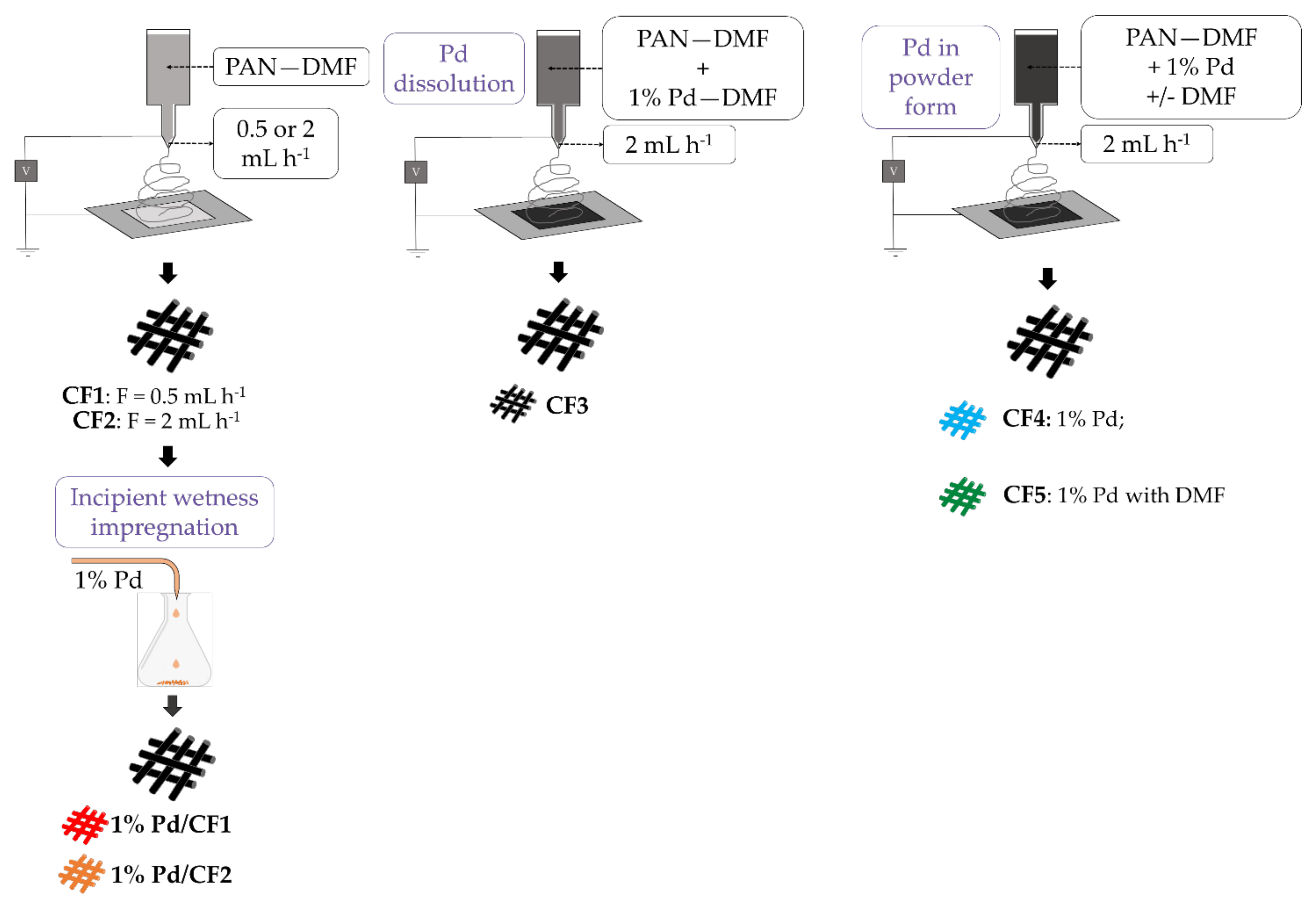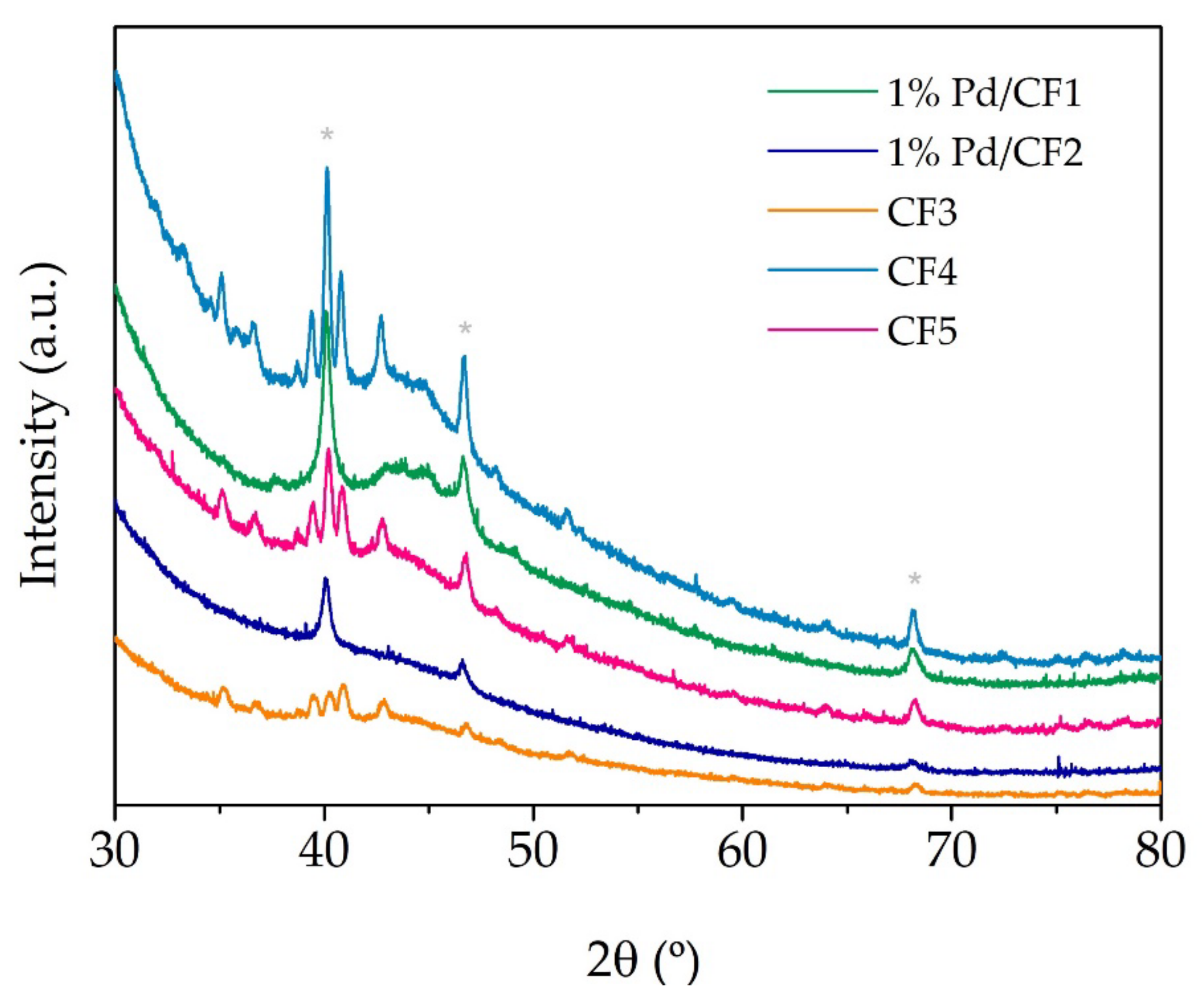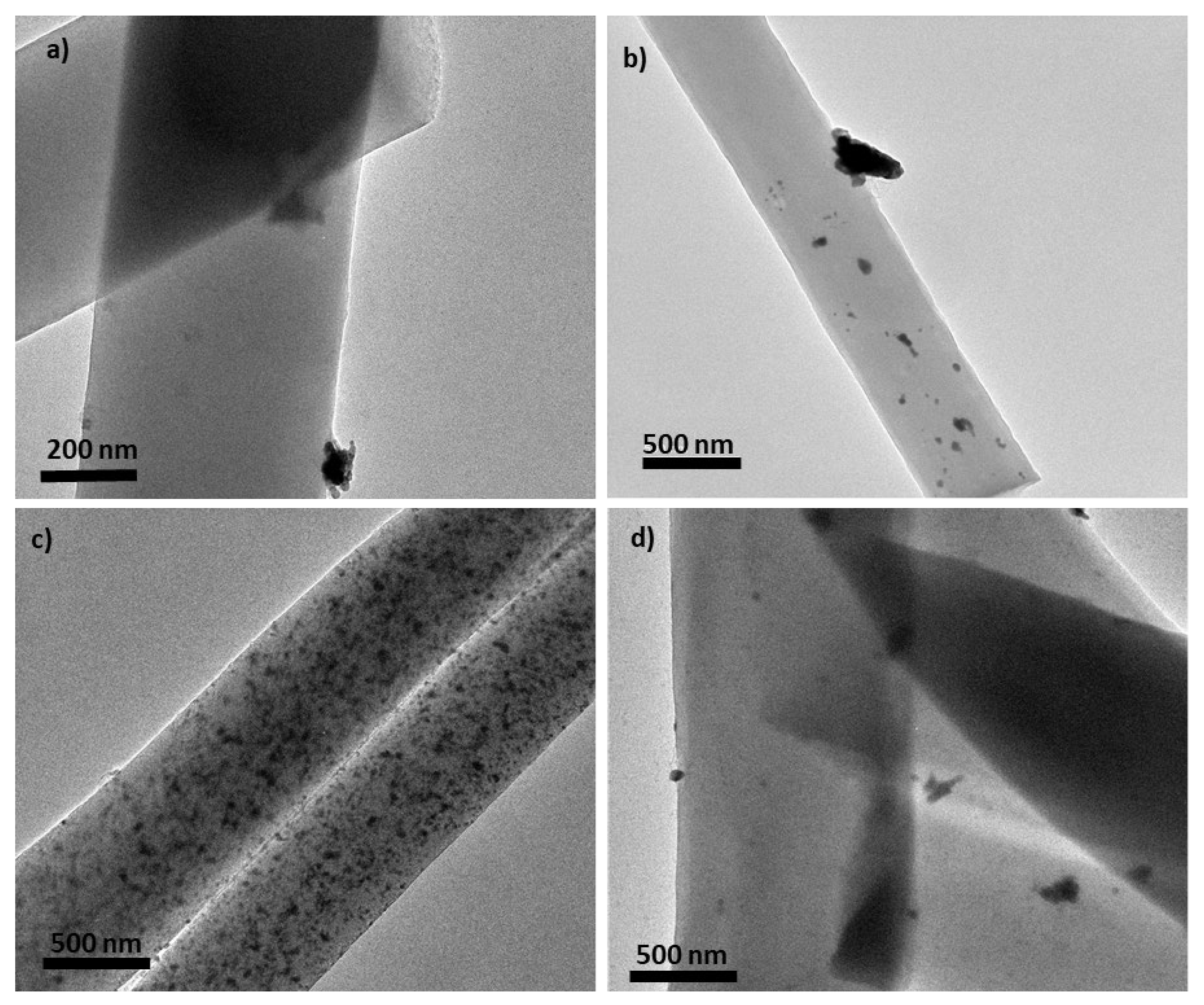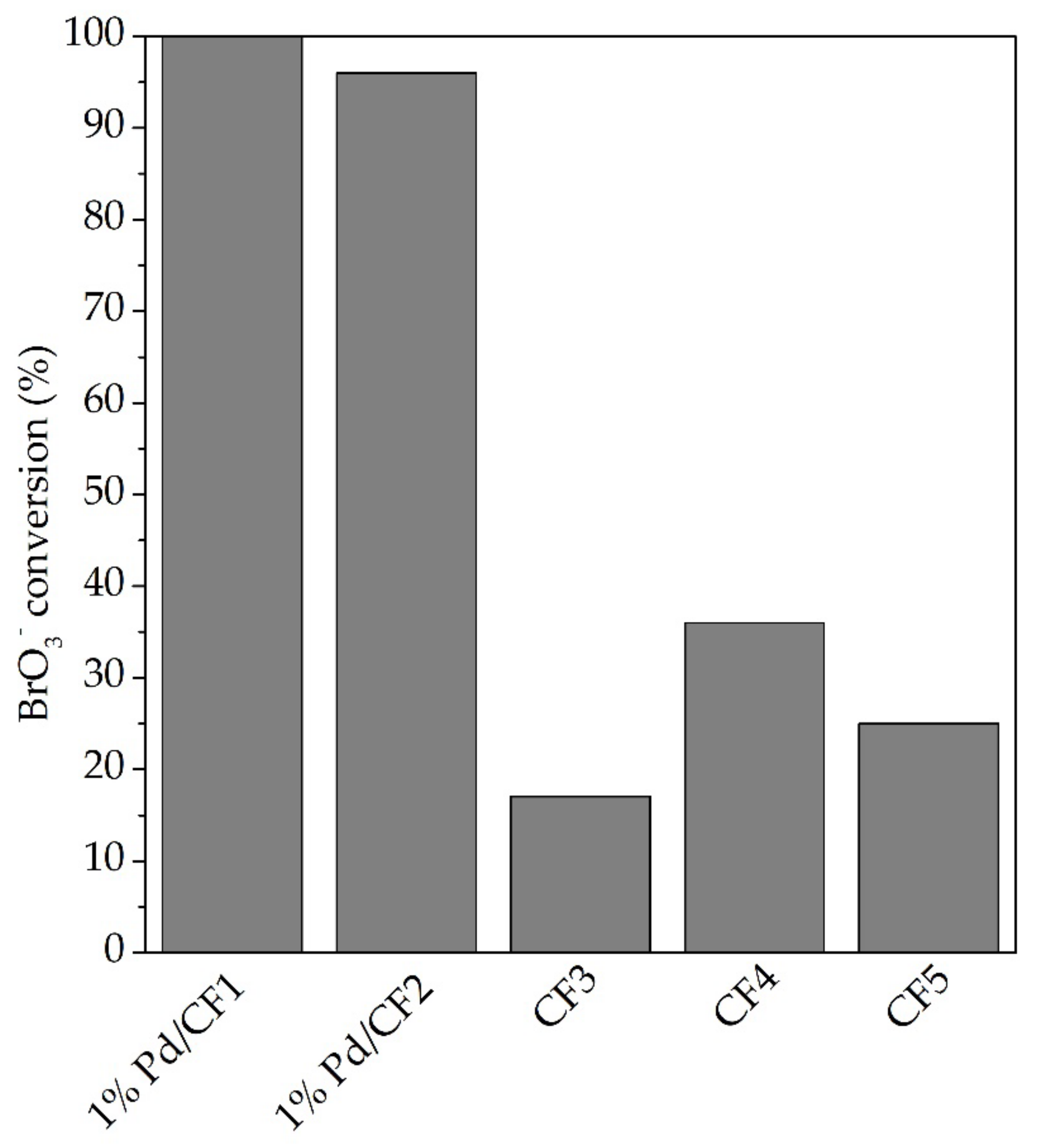Palladium Impregnation on Electrospun Carbon Fibers for Catalytic Reduction of Bromate in Water
Abstract
:1. Introduction
2. Materials and Methods
2.1. Materials
2.2. Catalysts Synthesis
2.2.1. Preparation of Carbon Nanofibers
2.2.2. Preparation of Pd/CFs by Incipient Wetness Impregnation Method
2.2.3. Preparation of Pd/CFs by the sol-gel Method
2.3. Materials Characterization
2.4. BrO3− Removal Experiments
3. Results and Discussion
3.1. Characterization of Pd-CFs Composite Catalysts
3.2. Catalytic Tests
4. Conclusions
Author Contributions
Funding
Conflicts of Interest
References
- Potters, G. What is pollution? In Marine Pollution; Oxford University Press: Oxford, UK, 2013. [Google Scholar]
- Quick, C.; Chole, R.; Manuer, S. Deafness and renal failure due to potassium bromate poisoning. Arch. Otolaryngol. 1975, 101, 494–495. [Google Scholar] [CrossRef] [PubMed]
- Health Canada. Overview and application. In Guidelines for Canadian Drinking Water Quality: Guideline Technical Document-Bromate; Water and Air Quality Bureau, Healthy Environments and Consumer Safety Branch, Health Canada: Ottawa, ON, Canada, 2016. [Google Scholar]
- Butler, R.; Godley, A.; Lytton, L.; Cartmell, E. Bromate Environmental Contamination: Review of Impact and Possible Treatment. Crit. Rev. Environ. Sci. Technol. 2005, 35, 193–217. [Google Scholar] [CrossRef]
- Dodd, D.E.; Layko, D.K.; Cantwell, K.E.; Willson, G.A.; Thomas, R.S. Subchronic toxicity evaluation of potassium bromate in Fischer 344 rats. Environ. Toxicol. Pharmacol. 2013, 36, 1227–1234. [Google Scholar] [CrossRef] [PubMed]
- Hutchinson, T.; Hutchings, M.; Moore, K. A Review of the Effects of Bromate on Aquatic Organisms and Toxicity of Bromate to Oyster (Crassostrea gigas) Embryos. Ecotoxicol. Environ. Saf. 1997, 38, 238–243. [Google Scholar] [CrossRef]
- Kruithof, J.; Meijers, R. Bromate formation by ozonation and advanced oxidation and potential options in drinking water treatment. Water Supply 1995, 13, 93–103. [Google Scholar]
- IPCS. Chemistry of disinfectants and disinfectant by-products. In Disinfectants and Disinfectant by-Products; World Health Organization, Internation Programme on Chemical Safety: Geneva, Switzerland, 2000. [Google Scholar]
- Haag, W.; Hoigne, J. Ozonation of bromide-containing waters: Kinetics of formation of hypobromous acid and bromate. Environ. Sci. Technol. 1983, 17, 261–267. [Google Scholar] [CrossRef]
- IARC. Potassium Bromate (Summary of Data Reported and Evaluation); IARC: Lyon, France, 1999. [Google Scholar]
- USEPA. Public Health Goals for Chemicals in Drinking Water-Bromate; United States Environmental Protection Agency: San Francisco, CA, USA, 2009.
- World Health Organization. Guidelines for Drinking-Water Quality; WHO Press: Geneva, Switzerland, 2008; Volume 1. [Google Scholar]
- Meijers, R.; Kruithof, J. Potential treatment options for restriction of bromate formation and bromate removal. Water Supply 1995, 13, 183–189. [Google Scholar]
- Prados-Ramirez, M.; Ciba, N.; Bourbigot, M. Available techniques for reducing bromate in drinking water. Water Supply 1995, 13, 61–70. [Google Scholar]
- Peldszuz, S.; Andrews, S.; Souza, R.; Smith, F.; Douglas, I.; Bolton, J.; Huck, P. Effect of medium-pressure UV irradiation on bromate concentrations in drinking water, a pilot-scale study. Water Res. 2004, 38, 211–217. [Google Scholar] [CrossRef]
- Siddiqui, M.; Amy, G.; Ozekin, K.; Zhai, W.; Westerhoff, P. Alternative strategies for removing bromate. J. Am. Water Work. Assoc. 1994, 86, 81–96. [Google Scholar] [CrossRef]
- Gordon, G.; Gauw, R.; Emmert, G.; Walters, B.; Bubnis, B. Chemical reduction methods for bromate ion removal. J. Am. Water Work. Assoc. 2002, 94, 91–98. [Google Scholar] [CrossRef]
- Westerhoff, P. Reduction of nitrate, bromate, and chlorate by zero-valent iron (Fe0). J. Environ. Eng. 2003, 129, 10–16. [Google Scholar] [CrossRef]
- Siddiqui, M.S.; Amy, G.L.; Cooper, W.J. Bromate ion removal by electric-arc discharge and high-energy electron beam processes. In Water Disinfection and Natural Organic Matter; American Chemical Society: Washington, DC, USA, 1996; Volume 649, pp. 366–383. [Google Scholar]
- Hijnen, W.; Jong, R.; van der Kooij, D. Bromate removal in a denitrifying bioreactor used in water treatment. Water Res. 1999, 33, 1049–1053. [Google Scholar] [CrossRef]
- Centi, G.; Perathoner, S. Remediation of water contamination using catalytic technologies. Appl. Catal. B Environ. 2003, 41, 15–29. [Google Scholar] [CrossRef]
- McAdam, E.J.; Judd, S.J. Biological treatment of ion-exchange brine regenerant for re-use: A review. Sep. Purifcation Technol. 2008, 62, 264–272. [Google Scholar] [CrossRef]
- Liu, J.; Choe, J.; Sasnow, Z.; Werth, C.; Strathmann, T. Application of a Re–Pd bimetallic catalyst for treatment of perchlorate in waste ion-exchange regenerant brine. Water Res. 2013, 47, 91–101. [Google Scholar] [CrossRef]
- Choe, J.K.; Mehnert, M.H.; Guest, J.S.; Strathmann, T.J.; Werth, C.J. Comparative Assessment of the Environmental Sustainability of Existing and Emerging Perchlorate Treatment Technologies for Drinking Water. Environ. Sci. Technol. 2013, 47, 4644–4652. [Google Scholar] [CrossRef]
- Choe, J.; Bergquist, A.; Jeong, S.; Guest, J.; Werth, C.; Strathmann, T. Performance and life cycle environmental benefits of recycling spent ion exchange brines by catalytic treatment of nitrate. Water Res. 2015, 80, 267–280. [Google Scholar] [CrossRef]
- Prüsse, U.; Vorlop, K. Supported bimetallic palladium catalysts for water-phase nitrate reduction. J. Mol. Catal. A Chem. 2001, 173, 313–328. [Google Scholar] [CrossRef]
- Liu, J.; Choe, J.K.; Wang, Y.; Shapley, J.R.; Werth, C.J.; Strathmann, T.J. Bioinspired Complex-Nanoparticle Hybrid Catalyst System for Aqueous Perchlorate Reduction: Rhenium Speciation and Its Influence on Catalyst Activity. ACS Catal. 2015, 5, 511–522. [Google Scholar] [CrossRef]
- Perez-Coronado, A.M.; Soares, O.S.G.P.; Calvo, L.; Rodriguez, J.J.; Gilarranz, M.A.; Pereira, M.F.R. Catalytic reduction of bromate over catalysts based on Pd nanoparticles synthesized via water-in-oil microemulsion. Appl. Catal. B Environ. 2018, 237, 206–213. [Google Scholar] [CrossRef]
- Tokazhanov, G.; Ramazanova, E.; Hamid, S.; Bae, S.; Lee, W. Advances in the catalytic reduction of nitrate by metallic catalysts for high efficiency and N2 selectivity: A review. Chem. Eng. J. 2020, 384, 123252. [Google Scholar] [CrossRef]
- Hamid, S.; Bae, S.; Lee, W.; Amin, M.T.; Alazba, A.A. Catalytic Nitrate Removal in Continuous Bimetallic Cu–Pd/Nanoscale Zerovalent Iron System. Ind. Eng. Chem. Res. 2015, 54, 6247–6257. [Google Scholar] [CrossRef]
- Thakur, D.B.; Tiggelaar, R.M.; Weber, Y.; Gardeniers, J.G.E.; Lefferts, L.; Seshan, K. Ruthenium catalyst on carbon nanofiber support layers for use in silicon-based structured microreactors. Part II: Catalytic reduction of bromate contaminants in aqueous phase. Appl. Catal. B Environ. 2011, 102, 243–250. [Google Scholar] [CrossRef]
- Sakamoto, Y.; Kamiya, Y.; Okuhara, T. Selective hydrogenation of nitrate to nitrite in water over Cu-Pd bimetallic clusters supported on active carbon. J. Mol. Catal. A Chem. 2006, 250, 80–86. [Google Scholar] [CrossRef]
- Freitas, C.M.A.S.; Soares, O.S.G.P.; Órfão, J.J.M.; Fonseca, A.M.; Pereira, M.F.R.; Neves, I.C. Highly efficient reduction of bromate to bromide over mono and bimetallic ZSM5 catalysts. Green Chem. 2015, 17, 4247–4254. [Google Scholar] [CrossRef]
- Soares, O.S.G.P.; Freitas, C.M.A.S.; Fonseca, A.M.; Órfão, J.J.M.; Pereira, M.F.R.; Neves, I.C. Bromate reduction in water promoted by metal catalysts prepared over faujasite zeolite. Chem. Eng. J. 2016, 291, 199–205. [Google Scholar] [CrossRef]
- Bae, S.; Jung, J.; Lee, W. The effect of pH and zwitterionic buffers on catalytic nitrate reduction by TiO2-supported bimetallic catalyst. Chem. Eng. J. 2013, 232, 327–337. [Google Scholar] [CrossRef]
- Chen, X.; Huo, X.; Liu, J.; Wang, Y.; Werth, C.J.; Strathmann, T.J. Exploring beyond palladium: Catalytic reduction of aqueous oxyanion pollutants with alternative platinum group metals and new mechanistic implications. Chem. Eng. J. 2017, 313, 745–752. [Google Scholar] [CrossRef] [Green Version]
- Soares, O.S.G.P.; Órfão, J.J.M.; Pereira, M.F.R. Activated Carbon Supported Metal Catalysts for Nitrate and Nitrite Reduction in Water. Catal. Lett. 2008, 126, 253–260. [Google Scholar] [CrossRef]
- Restivo, J.; Soares, O.S.G.P.; Órfão, J.J.M.; Pereira, M.F.R. Metal assessment for the catalytic reduction of bromate in water under hydrogen. Chem. Eng. J. 2015, 263, 119–126. [Google Scholar] [CrossRef]
- Restivo, J.; Soares, O.S.G.P.; Órfão, J.J.M.; Pereira, M.F.R. Bimetallic activated carbon supported catalysts for the hydrogen reduction of bromate in water. Catal. Today 2015, 249, 213–219. [Google Scholar] [CrossRef] [Green Version]
- Zhao, W.; Zhu, X.; Wang, Y.; Ai, Z.; Zhao, D. Catalytic reduction of aqueous nitrates by metal supported catalysts on Al particles. Chem. Eng. J. 2014, 254, 410–417. [Google Scholar] [CrossRef]
- Bae, S.; Hamid, S.; Jung, J.; Sihn, Y.; Lee, W. Effect of promoter and noble metals and suspension pH on catalytic nitrate reduction by bimetallic nanoscale Fe0 catalysts. Environ. Technol. 2016, 37, 1077–1087. [Google Scholar] [CrossRef] [PubMed]
- Hamid, S.; Kumar, M.A.; Lee, W. Highly reactive and selective Sn-Pd bimetallic catalyst supported by nanocrystalline ZSM-5 for aqueous nitrate reduction. Appl. Catal. B Environ. 2016, 187, 37–46. [Google Scholar] [CrossRef]
- Hamid, S.; Bae, S.; Lee, W. Novel bimetallic catalyst supported by red mud for enhanced nitrate reduction. Chem. Eng. J. 2018, 348, 877–887. [Google Scholar] [CrossRef]
- Restivo, J.; Soares, O.S.G.P.; Órfão, J.J.M.; Pereira, M.F.R. Catalytic reduction of bromate over monometallic catalysts on different powder and structured supports. Chem. Eng. J. 2017, 309, 197–205. [Google Scholar] [CrossRef]
- Chen, H.; Xu, Z.; Wan, H.; Zheng, J.; Yin, D.; Zheng, S. Aqueous bromate reduction by catalytic hydrogenation over Pd/Al2O3 catalysts. Appl. Catal. B Environ. 2010, 96, 307–313. [Google Scholar] [CrossRef]
- Wang, Y.; Liu, J.; Wang, P.; Werth, C.J.; Strathmann, T.J. Palladium Nanoparticles Encapsulated in Core–Shell Silica: A Structured Hydrogenation Catalyst with Enhanced Activity for Reduction of Oxyanion Water Pollutants. ACS Catal. 2014, 4, 3551–3559. [Google Scholar] [CrossRef]
- Bruning-Fann, C.S.; Kaneene, J.B. The effects of nitrate, nitrite and N-nitroso compounds on human health: A review. Vet. Hum. Toxicol. 1993, 35, 521–538. [Google Scholar]
- Boorman, G.A.; Dellarco, V.; Dunnick, J.K.; Chapin, R.E.; Hunter, S.; Hauchman, F.; Gardner, H.; Mike, C.; Sills, R.C. Drinking water disinfection byproducts: Review and approach to toxicity evaluation. Environ. Health Perspect. 1999, 107, 207–217. [Google Scholar] [PubMed]
- Greer, M.A.; Goodman, G.; Pleus, R.C.; Greer, S.E. Health effects assessment for environmental perchlorate contamination: The dose response for inhibition of thyroidal radioiodine uptake in humans. Environ. Health Perspect. 2002, 110, 927–937. [Google Scholar] [CrossRef] [PubMed] [Green Version]
- Shuai, D.; McCalman, D.C.; Choe, J.K.; Shapley, J.R.; Schneider, W.F.; Werth, C.J. Structure Sensitivity Study of Waterborne Contaminant Hydrogenation Using Shape- and Size-Controlled Pd Nanoparticles. ACS Catal. 2013, 3, 453–463. [Google Scholar] [CrossRef]
- Soares, O.S.G.P.; Ramalho, P.S.F.; Fernandes, A.; Órfão, J.J.M.; Pereira, M.F.R. Catalytic bromate reduction in water: Influence of carbon support. J. Environ. Chem. Eng. 2019, 7, 103015. [Google Scholar] [CrossRef]
- Demir, M.M.; Gulgun, M.A.; Menceloglu, Y.Z.; Erman, B.; Abramchuk, S.S.; Makhaeva, E.E.; Khokhlov, A.R.; Matveeva, V.G.; Sulman, M.G. Palladium Nanoparticles by Electrospinning from Poly(acrylonitrile-co-acrylic acid)-PdCl2 Solutions. Relations between Preparation Conditions, Particle Size, and Catalytic Activity. Macromolecules 2004, 37, 1787–1792. [Google Scholar] [CrossRef] [Green Version]
- Wang, C.; Yin, J.; Han, S.; Jiao, T.; Bai, Z.; Zhou, J.; Zhang, L.; Peng, Q. Preparation of Palladium Nanoparticles Decorated Polyethyleneimine/Polycaprolactone Composite Fibers Constructed by Electrospinning with Highly Efficient and Recyclable Catalytic Performances. Catalysts 2019, 9, 559. [Google Scholar] [CrossRef] [Green Version]
- Marco, Y.; García-Bordejé, E.; Franch, C.; Palomares, A.E.; Yuranova, T.; Kiwi-Minsker, L. Bromate catalytic reduction in continuous mode using metal catalysts supported on monoliths coated with carbon nanofibers. Chem. Eng. J. 2013, 230, 605–611. [Google Scholar] [CrossRef]
- Guerrero-Pérez, M.O. Research Progress on the Applications of Electrospun Nanofibers in Catalysis. Catalysts 2021, 12, 9. [Google Scholar] [CrossRef]
- Barakat, N.A.M.; Motlak, M.; Elzatahry, A.A.; Khalil, K.A.; Abdelghani, E.A.M. NixCo1−x alloy nanoparticle-doped carbon nanofibers as effective non-precious catalyst for ethanol oxidation. Int. J. Hydrog. Energy 2014, 39, 305–316. [Google Scholar] [CrossRef]
- Reichelt, E.; Heddrich, M.P.; Jahn, M.; Michaelis, A. Fiber based structured materials for catalytic applications. Appl. Catal. A Gen. 2014, 476, 78–90. [Google Scholar] [CrossRef]
- Sin, D.-Y.; An, G.-H.; Ahn, H.-J. Improved Methanol Electro-Oxidation of Pt Electrocatalysts on Porous Carbon Nanofiber—Ruthenium Core—Shell Supports. J. Nanosci. Nanotechnol. 2016, 16, 10535–10540. [Google Scholar] [CrossRef]
- Alvi, M.A.; Akhtar, M.S. An effective and low cost Pd Ce bimetallic decorated carbon nanofibers as electro-catalyst for direct methanol fuel cells applications. J. Alloy. Compd. 2016, 684, 524–529. [Google Scholar] [CrossRef]
- Jiang, S.; Li, J.; Fang, J.; Wang, X. Fibrous-Structured Freestanding Electrodes for Oxygen Electrocatalysis. Small 2021, 17, 1903760. [Google Scholar] [CrossRef] [PubMed]
- Liu, C.-K.; Lai, K.; Liu, W.; Yao, M.; Sun, R.-J. Preparation of carbon nanofibres through electrospinning and thermal treatment. Polym. Int. 2009, 58, 1341–1349. [Google Scholar] [CrossRef]
- Soares, O.S.G.P.; Órfão, J.J.M.; Pereira, M.F.R. Nitrate reduction with hydrogen in the presence of physical mixtures with mono and bimetallic catalysts and ions in solution. Appl. Catal. B Environ. 2011, 102, 424–432. [Google Scholar] [CrossRef]
- Soares, O.S.G.P.; Órfão, J.J.M.; Ruiz-Martínez, J.; Silvestre-Albero, J.; Sepúlveda-Escribano, A.; Pereira, M.F.R. Pd–Cu/AC and Pt–Cu/AC catalysts for nitrate reduction with hydrogen: Influence of calcination and reduction temperatures. Chem. Eng. J. 2010, 165, 78–88. [Google Scholar] [CrossRef]
- Lowell, S.; Shields, J.E.; Thomas, M.A.; Thommes, M. Surface area analysis from the langmuir and BET theories. In Characterization of Porous Solids and Powders: Surface Area, Pore Size and Density; Springer: Dordrecht, The Netherlands, 2004; Volume 16, pp. 58–81. [Google Scholar]
- Wannatong, L.; Sirivat, A.; Supaphol, P. Effects of solvents on electrospun polymeric fibers: Preliminary study on polystyrene. Polym. Int. 2004, 53, 1851–1859. [Google Scholar] [CrossRef]
- Zuo, W.; Zhu, M.; Yang, W.; Yu, H.; Chen, Y.; Zhang, Y. Experimental study on relationship between jet instability and formation of beaded fibers during electrospinning. Polym. Eng. Sci. 2005, 45, 704–709. [Google Scholar] [CrossRef]
- Megelski, S.; Stephens, J.S.; Chase, D.B.; Rabolt, J.F. Micro- and Nanostructured Surface Morphology on Electrospun Polymer Fibers. Macromolecules 2002, 35, 8456–8466. [Google Scholar] [CrossRef]
- Zong, X.; Kim, K.; Fang, D.; Ran, S.; Hsiao, B.S.; Chu, B. Structure and process relationship of electrospun bioabsorbable nanofiber membranes. Polymer 2002, 43, 4403–4412. [Google Scholar] [CrossRef]
- Geng, X.; Kwon, O.; Jang, J. Electrospinning of chitosan dissolved in concentrated acetic acid solution. Biomaterials 2005, 26, 5427–5432. [Google Scholar] [CrossRef] [PubMed]
- Bhardwaj, N.; Kundu, S.C. Electrospinning: A fascinating fiber fabrication technique. Biotechnol. Adv. 2010, 28, 325–347. [Google Scholar] [CrossRef] [PubMed]
- Horzum, N.; Boyacı, E.; Eroğlu, A.E.; Shahwan, T.; Demir, M.M. Sorption Efficiency of Chitosan Nanofibers toward Metal Ions at Low Concentrations. Biomacromolecules 2010, 11, 3301–3308. [Google Scholar] [CrossRef] [PubMed] [Green Version]
- Formo, E.; Peng, Z.; Lee, E.; Lu, X.; Yang, H.; Xia, Y. Direct Oxidation of Methanol on Pt Nanostructures Supported on Electrospun Nanofibers of Anatase. J. Phys. Chem. C Lett. 2008, 112, 9970–9975. [Google Scholar] [CrossRef]
- Figueiredo, J.L.; Ribeiro, F.R. Actividade e selectividade. In Catálise Heterogénea, 2nd ed.; Fundação Calouste Gulbenkian: Lisbon, Portugal, 2007. [Google Scholar]
- Hedden, R.; Bauer, B.J.; Smith, A.P.; Gröhn, F.; Amis, E. Templating of inorganic nanoparticles by PAMAM/PEG dendrimer–star polymers. Polymer 2002, 43, 5473–5481. [Google Scholar] [CrossRef]
- Ye, J.-S.; Liu, Z.-T.; Lai, C.-C.; Lo, C.-T.; Lee, C.-L. Diameter effect of electrospun carbon fiber support for the catalysis of Pt nanoparticles in glucose oxidation. Chem. Eng. J. 2016, 283, 304–312. [Google Scholar] [CrossRef]
- Cerrillo, J.L.; Lopes, C.W.; Rey, F.; Palomares, A.E. The Influence of the Support Nature and the Metal Precursor in the Activity of Pd-based Catalysts for the Bromate Reduction Reaction. ChemCatChem 2021, 13, 1230–1238. [Google Scholar] [CrossRef]
- Sun, W.; Li, Q.; Gao, S.; Shang, J.K. Highly efficient catalytic reduction of bromate in water over a quasi-monodisperse, superparamagnetic Pd/Fe3O4 catalyst. J. Mater. Chem. A 2013, 1, 9215. [Google Scholar] [CrossRef]








| Catalyst | SBET (m2 g−1) ± 5 m2 g−1 | dpores (nm) |
|---|---|---|
| CF1 | 20 | 1.2 |
| 1% Pd/CF1 | 25 | 2.3 |
| CF2 | 51 | 2.1 |
| 1% Pd/CF2 | 47 | 2.1 |
| CF3 | 344 | 1.2 |
| CF4 | 75 | 1.2 |
| CF5 | 143 | 1.2 |
| Sample | %Volatiles | % Cfixed | %Ashes | H2 Consumption (mmol g−1) |
|---|---|---|---|---|
| CF1 | 9 | 80 | 3 | ND * |
| 1% Pd/CF1 | 14 | 70 | 6 | 1.49 |
| CF2 | 9 | 75 | 6 | ND |
| 1% Pd/CF2 | 10 | 70 | 11 | 1.62 |
| CF3 | 11 | 68 | 9 | 0.11 |
| CF4 | 10 | 75 | 6 | 0.09 |
| CF5 | 10 | 77 | 4 | 0.07 |
| Catalysts | |||||
|---|---|---|---|---|---|
| 1% Pd/CF1 | 1% Pd/CF2 | CF3 | CF4 | CF5 | |
| Pd (mg g−1) | 1.05 | 0.99 | 1.20 | 1.10 | 0.95 |
| Catalyst | H2 Chemisorption (mol g−1) | k (min−1)t = 15 min | SM (m2 g−1) | TOF (g m−2 min−1) |
|---|---|---|---|---|
| 1% Pd/CF1 | 1.49 | 0.176 | 70.7 | 2.49 × 10−3 |
| 1% Pd/CF2 | 1.62 | 0.068 | 76.8 | 8.87 × 10−4 |
| CF3 | 0.11 | 0.005 | 5.22 | 9.88 × 10−4 |
| CF4 | 0.09 | 0.018 | 4.27 | 4.27 × 10−3 |
| CF5 | 0.07 | 0.013 | 3.32 | 4.03 × 10−3 |
| Support/Catalyst | Incorporation Method | BrO3− Initial Concentration (mmol L−1) | Loading of the Catalyst (mg L−1) | BrO3− Conversion after 5 min (%) | Ref. |
|---|---|---|---|---|---|
| Hydrotalcite | Impregnation | 0.390 | 833 | 2 | [76] |
| AC | Impregnation | 0.390 | 833 | 7 | |
| Al2O3 | Impregnation | 0.390 | 833 | 12 | |
| TiO2 | Impregnation | 0.078 | 250 | 100 | [44] |
| MWCNT | Impregnation | 0.078 | 250 | 55 | |
| Zeolite (FAU) | Ion-exchange | 0.078 | 125 | 18 | [34] |
| Fe3O4 paramagnetic | Adsorption-impregnation | 0.390 | 200 | 35 | [77] |
| 1% Pd/CF1 | Impregnation | 0.039 | 250 | 65 | In this study |
Publisher’s Note: MDPI stays neutral with regard to jurisdictional claims in published maps and institutional affiliations. |
© 2022 by the authors. Licensee MDPI, Basel, Switzerland. This article is an open access article distributed under the terms and conditions of the Creative Commons Attribution (CC BY) license (https://creativecommons.org/licenses/by/4.0/).
Share and Cite
Barbosa, J.R.M.; Sousa, J.P.S.; Restivo, J.; Pereira, M.F.R.; Soares, O.S.G.P. Palladium Impregnation on Electrospun Carbon Fibers for Catalytic Reduction of Bromate in Water. Processes 2022, 10, 458. https://doi.org/10.3390/pr10030458
Barbosa JRM, Sousa JPS, Restivo J, Pereira MFR, Soares OSGP. Palladium Impregnation on Electrospun Carbon Fibers for Catalytic Reduction of Bromate in Water. Processes. 2022; 10(3):458. https://doi.org/10.3390/pr10030458
Chicago/Turabian StyleBarbosa, José R. M., Juliana P. S. Sousa, João Restivo, Manuel F. R. Pereira, and Olívia S. G. P. Soares. 2022. "Palladium Impregnation on Electrospun Carbon Fibers for Catalytic Reduction of Bromate in Water" Processes 10, no. 3: 458. https://doi.org/10.3390/pr10030458
APA StyleBarbosa, J. R. M., Sousa, J. P. S., Restivo, J., Pereira, M. F. R., & Soares, O. S. G. P. (2022). Palladium Impregnation on Electrospun Carbon Fibers for Catalytic Reduction of Bromate in Water. Processes, 10(3), 458. https://doi.org/10.3390/pr10030458










